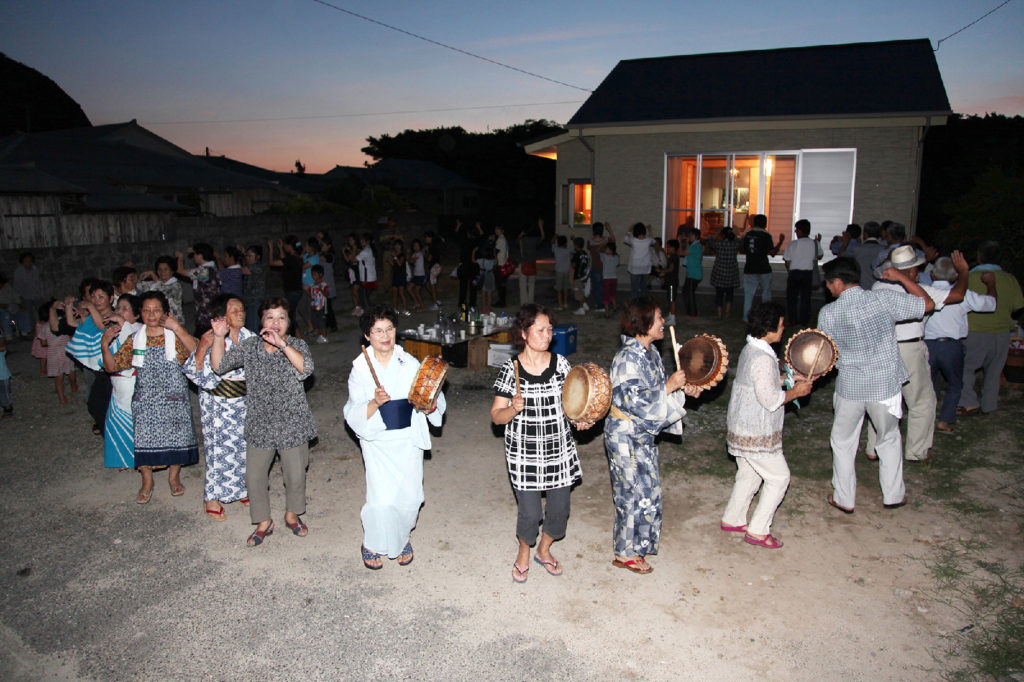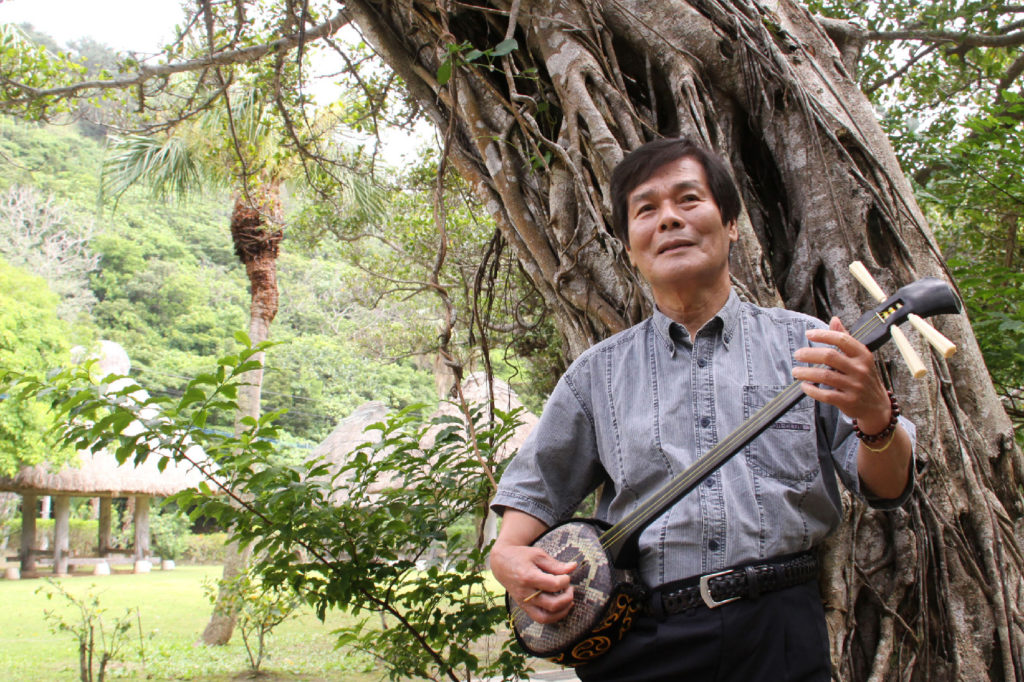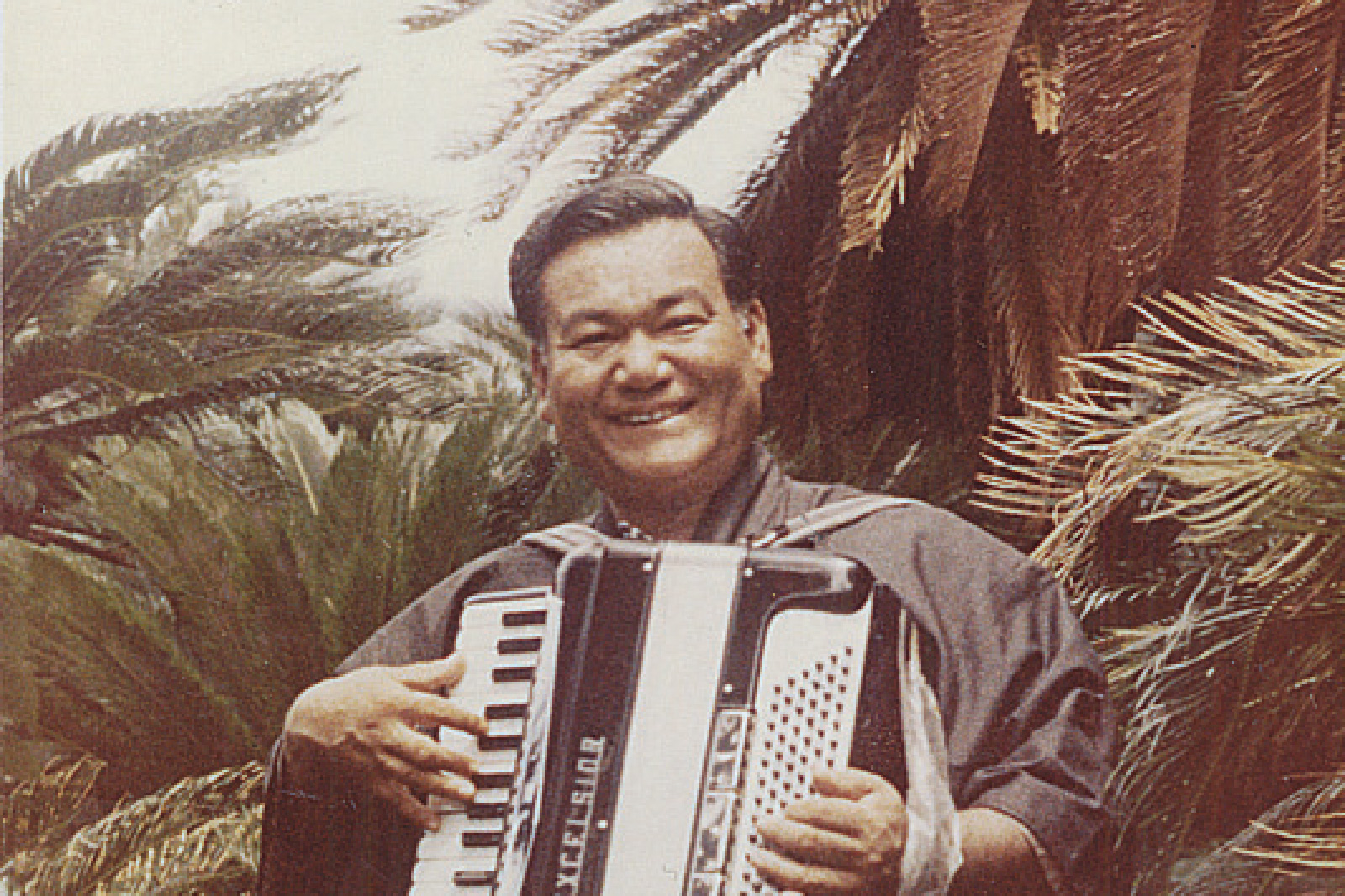
Island of songs
Amami New Folk Songs
From the late Taisho era (1912-1926) to the early Showa era (1926-1989), “a new folk song boom” abounded nationwide. Compared to folk songs, both the songwriters and composers of new folk songs are clear and the new folk song can be expressed in musical score, though there are some exceptions.
New folk songs were also composed in the Amami Islands. As the prewar new folk songs, there are such idyllic songs as “Erabu Yurino Hana (Lilies of Erab Island)”, “Tsukino Shirahama (White sandy beach at moon night)”, “Isono Matsukaze (Wind blowing through the pine trees on the beach)”(1934 respectively) and so on, but the song “Shima Sodachi (Island-raised)” with a rich tropical mood is representative. As a feature of new folk songs, the names of place, dialect words, special products and so on are included in the lyrics. Part of the lyrics of the major songs are as below.
Songs of peaceful era before the war
Erabu Yuri no Hana (Lilies of Erabu Island) (1931)
Erabu Yuri no Hana Amerika ni Sakachi Yarekunu
Uriga Kogane Bana Shima ni Yoo Sakaso
Anga Yosato Naicha Shunga Shunga
We let the lilies of Erabu bloom in America, and let the flowers of gold bloom on our island.
(Koriyama, Naoshi 2001, Beautiful Amami Island Folk Songs, Tokyo: The Hokuseido Press, pp.188-189)
The lilies of Okierabu Island were exported to the United States of America. There was a year of overproduction and lily bulbs were dumped into the sea as a mean for price adjustment. This song was composed for the requiem of the dumped lilies and to boost the morale of the lily farmers.
Shima Sodachi (Island-raised) (1939)
Akai Sotetsu no Mi mo Ureru Koro Kana mo Toshigoro Kana mo Toshigoro Ooshima Sodachi
Kurushu Kurokami Unagu Mi no Kanasha Omoi Mamune ni Omoi Mamune ni Oru Shima Tsumugi
When the cycad red fruit is ripe, it’s a marriageable age for my beloved girl raised in Oshima.Black current, black hair, miss the girl weaving island pongee with heart
This is the most famous masterpiece in Amami, and broke through nationwide in 1962. Kana means a beloved one (one’s wife or girlfriend).
A song prior to the reversion to Japan
After the World War II, the Amami Islands were put under the jurisdiction of the US military government for eight years from 1946 to 1953. The cultural and material interaction with mainland Japan was lost and returning to their homeland and nostalgia became the driving force for song making.
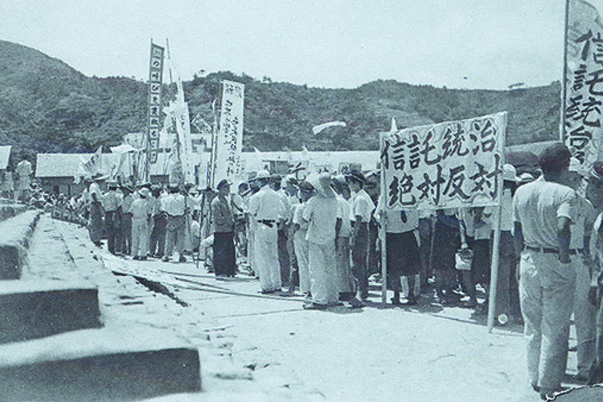
After the World War II, in the Amami Islands under the U.S. military government, return to Japan movement by the islanders and natives was developed. Many local love songs were also made (the photo by Kagoshima Prefecture).
Shima Kage (Island Scenery) (1947)
Tsuranaru Umi no Nishi Higashi
Wakareta Shima no Omoi nu Kanasha
West and east of the sea, the feeling of love for the separated islands
(Kanasha means beloved. This is the first song to sing that the Amami Islands were separated from mainland Japan. After that, a lot of memorable famous songs were born such as Naze Serenade, Honcha Touge, Miinishi Fukeba (1948 respectively), Yoake Mae (1949) and Nihon Fukki no Uta. The representative song is Noson Kouta, the lyric about the men who returned from battlefields changed gun to hoe and challenged the wasteland for family with hope evoked sympathy.
Noson Kouta (A Rural Song) (1948)
Touge no Karusa yo
Yare Kana to Uchuru Arajibate nu
Sore Touge no Karusa yo
How light hoe is, when plowing a rough field with a hoe with my beloved one
Touge is a three-pronged hoe.
Nihon Fukki no Uta (Song of Reversion to Japan) (1951)
Taiheiyo no Shio no Ne wa
Waga Douho no Chi no Sakebi
Heiwa to Jiyuu wo Shitaitsutsu
Tateru Minzoku Nijuuman
Retsu Retsu Inoru Dai Higan
Pacific tide sounds are the cry of the earth of my fellow.
Two hundred thousand of people uprose longing for peace and freedom and prayed hard for their great wish.
(The people of the Amami Islands developed a reversion movement with one heart while singing this song.)
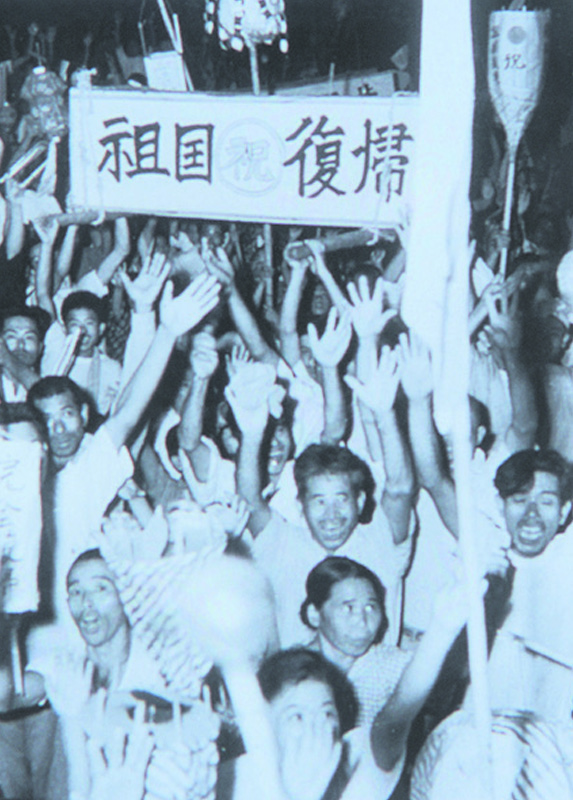
December 25th 1953, eight years of movement to return to Japan was realized, and islanders rejoicing to hurray.
Postwar Amami boom
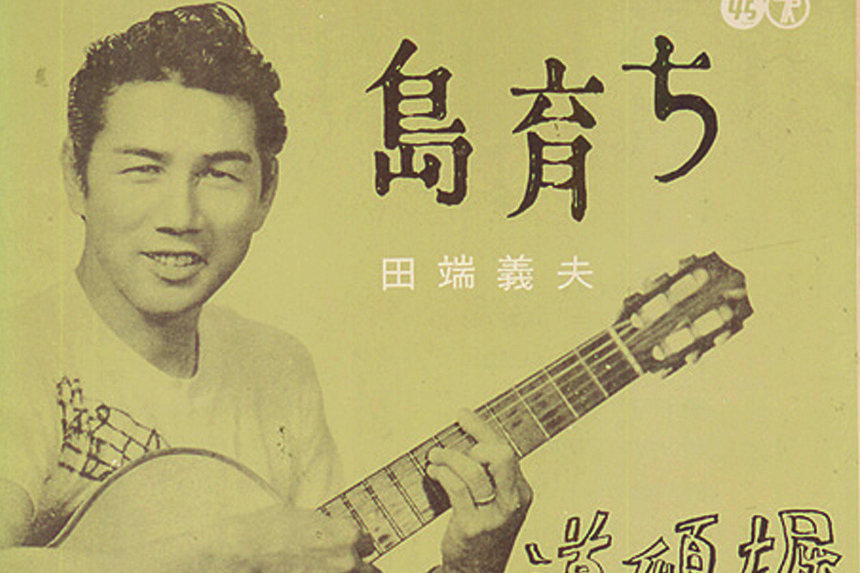
The record jacket of “Shima sodachi”. The song was sung by Yoshio Tabata in 1962 and caused an Amami boom nationwide.
Hataori Musume (A Weaving Girl) (1958)
Amami no Miyako Naze no Machi
Shingou no Mizu de Tehchigi Somete
Kayou Osa Oto Hohoemi Kawasu
Shima no Meisan Teori no Tsumugi
(This is a famous song that gave the weaving women the awareness and pride that they were supporting the Amami economy.)
Shima no Buruus (Island Blues) (1963)
Amami Nachikasha Sotetsu no Kage de
Nakeba Yuremasu Sanenbana yo
Nagai Kurokami Shima Musume
Shima Musume yo
(his is the best hit song in nationwide Amami boom that started with “Shima Sodachi”.
Song, shamisen, taiko, hayashi, dance and tropical mood were fully added to the song.)
Yoron Kouta
Watashi ga Anata ni Horeta nowa choudo Juuhachi Hanazakari
Imasara Rien to iu naraba
Moto no Juuhachi nashite kure
When I got married to you, I was just in full bloom of eighteen years old.
If you divorce me now, return me to the original age.
(Around late Meiji period, lyrics along the current topics were added to the song that the migrants from Yoron Island brought back.)
Waido-bushi
Waido waido waido wakya ushi waido zento-ichi waido Mikyo no yamakaze ikya arasate mo kanasharu ushi-gwa ni kusa karajiu karyume Uure ure ure temanke sunumanke hato fuke mashu make Uure ure ure wakya ushi waido zento-ichi waido
Our bull is the best of the whole island. No matter how strong the mountain wind of Mikyo is, we must mow the grass and feed them to our beloved bull. Dance with hands, dance with legs, blow a finger whistle, sprinkle salt. Our bull is the best of the whole island.
Waido is a yell. Lyrics mean that our bull is the best of the whole island. No matter how strong the mountain wind of Mikyho is, we must mow the grass and feed them to our bull. This song of Tokunoshima Island has been loved to sing throughout the islands of the Ryukyu Arc.
Amami-born new folk songs sent a cheer to Amami people as a song of love for their scenic home islands or of their will to Amami’s reversion to Japanese administration or of work. Amami’s new folk song became the history of Amami people beyond the category of song.

Jitsuo Murata who composed many of Amami new folksongs and was also active as a singer.
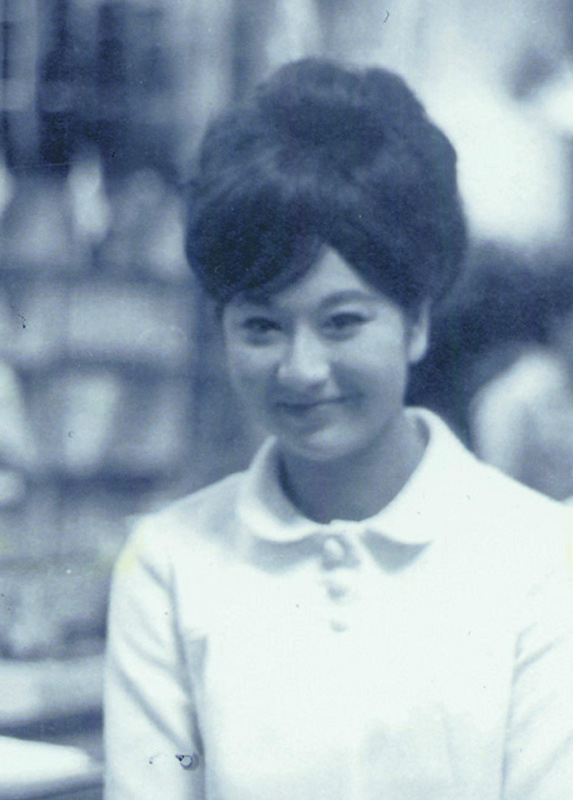
In 1963, the song “Shima no burusu” sung by Akemi Misawa became a big hit nationwide.

